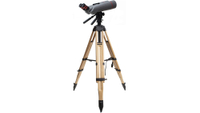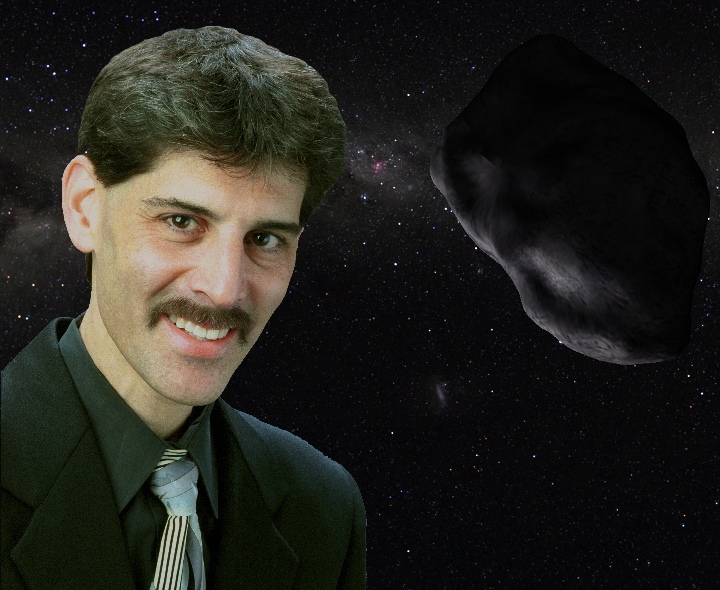Oberwerk's BT-XL-ED binocular telescopes bring nature's best of night and day
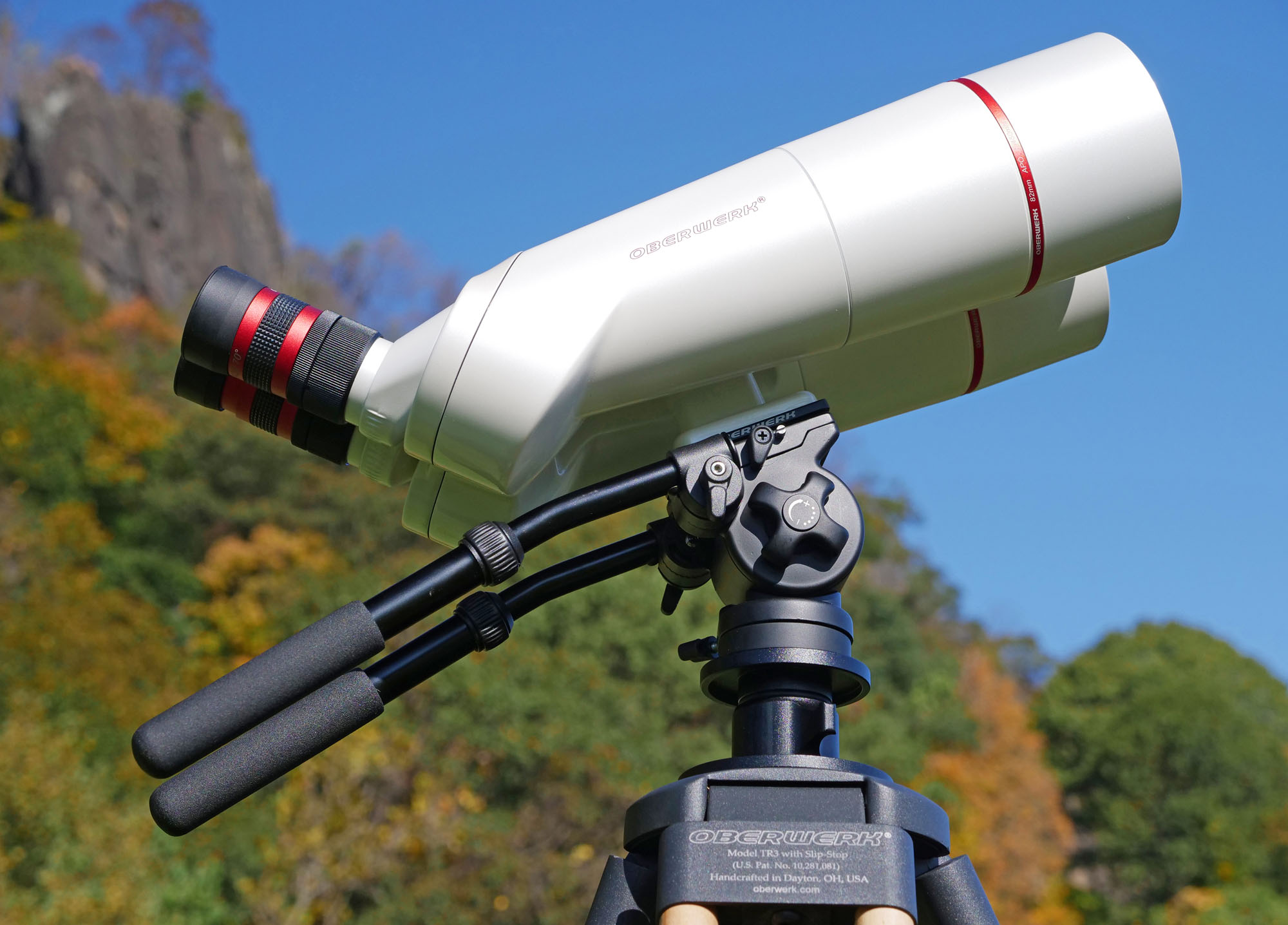
Your telescope probably spends too much time in the closet, not gathering starlight. I know. It's bulky, heavy; an inconvenient shape. It's not always easy to find the motivation to haul it out and set it up. Once you do, you have to convince friends and family members to contort their bodies, cocking their heads to the eyepiece, closing one eye just to see something. Your scope is locked on a target, so your guests can't really do their own exploring. And most telescopes don't give you a right-side-up image; they're useless for investigating all the fascinating faraway sights of Earth during the day.
What if your main observing tool was more compact — more comfortable to use, more fun during the day and more intuitive to point, yet as clear and sharp as the best telescope? And what if you could use both your eyes instead of only one, giving you deep 3D vision during the day and twice as much starlight at night?
A new generation of optically fast, distortion-free, lightweight, binocular telescopes is poised to change the way you experience the sky. Let me introduce you to one of the best examples: the BT-XL series from Oberwerk. There are five models in the range, sized by their objective lenses (the big lenses at the front): 70 mm ED at $1,350, 82 mm ED at $1,750, 100 mm ED at $2,395, 100 mm SD at $2,850, and 127 mm SD at $4,995.
Related: Best binoculars for astronomy, nature, sports and travel
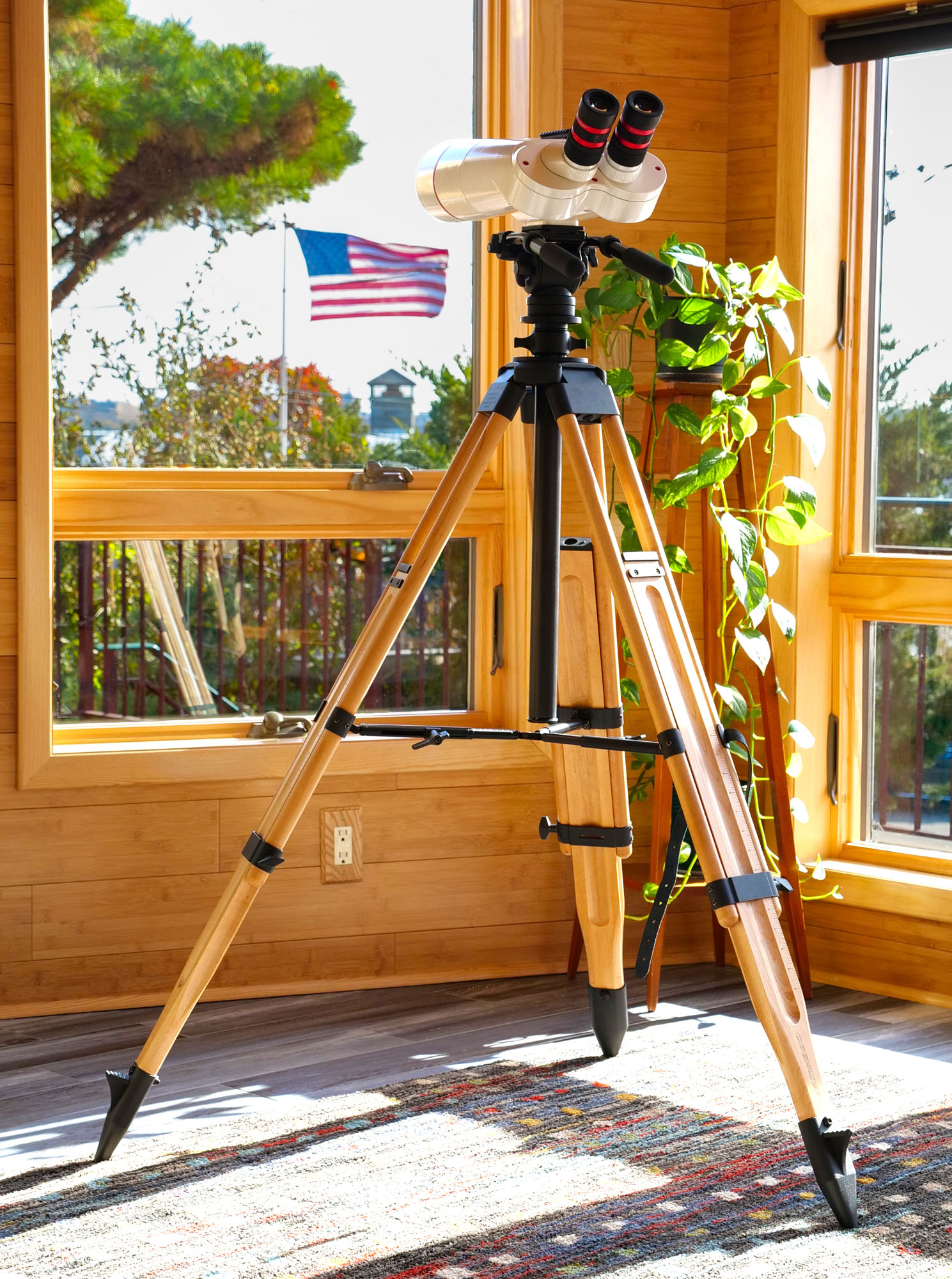
They share most design details: The adjustable-width eyepiece turrets are cleverly angled at 45 degrees for convenient viewing. Apochromatic "ED" (extra-low dispersion) optics preset a flat field, transmitting crisp and bright objects, free of colored artifacts. Or step up to superior dispersion "SD" glass for unparalleled image quality and temperature stability. Magnesium alloy construction keeps all XL's bodyweight to a minimum.
Oberwerk's matched sets of eyepieces are beautifully machined, smooth to focus, with a substantial "quality feel" to them. Or you may substitute your own pairs of standard 1.25-inch (3 centimeters) astronomy eyepieces and filters.
A built-in carry handle doubles as a mount block for customary finders and pointers. Tripod mounting is slip-on easy. Glare shields smoothly slide out around the big objective lenses. I can't think of a single requirement Oberwerk has missed.
Get the Space.com Newsletter
Breaking space news, the latest updates on rocket launches, skywatching events and more!
Let's take a deep dive into one of the popular models of this product line: the BT-82XL-ED binocular.
Big binocular evolution
Big binocular telescopes, optically "fast" enough to be capable of astronomy, have traditionally been expensive and heavy. The first ones to appear in the consumer market were military surplus in the early 1990s. Blocky and heavy, they were designed with opposing armies in mind, not amateur astronomers.
Next came a clutch of up-sized "handhelds on steroids" from hobbyist telescope manufacturers such as Orion, Celestron, Barska and Levenhuk. These were (and are) inexpensive ($250 to $450), but inconvenient (no angled eyepieces), and tend to be difficult to align to both your eyes. Focusing takes work, and image contrast is not very high; galaxies look like gray smudges.
Looking straight up at the sky through big binoculars is cumbersome. So, angled eyepieces — and the ability to adjust the distance between them — began to appear, under brand names like Vixen, Nikon and Newcon. These tend to be more expensive than the new Oberwerk XLs, but not as optically good; because they are "achromatic," you would notice annoying false-color fringes around bright objects. To step up to low-dispersion "ED" glass with a fully apochromatic light path that does not add these color artifacts used to carry a price tag of more than $7,500 if you could find them at all. Oberwerk has hacked that cost down by more than two-thirds; moreover, they've made a much more graceful product. The Oberwerk BT-82-XL-ED strikes an agreeable balance between day vs. night observing, and low cost vs. luxury features.
Out among the stars
With two eyes — and therefore both brain hemispheres — engaged in active observing through these fast, color-fringe free, wide-field optics, you can feel completely enveloped in the universe; "lost in space" with your feet still comfortably on terra firma.
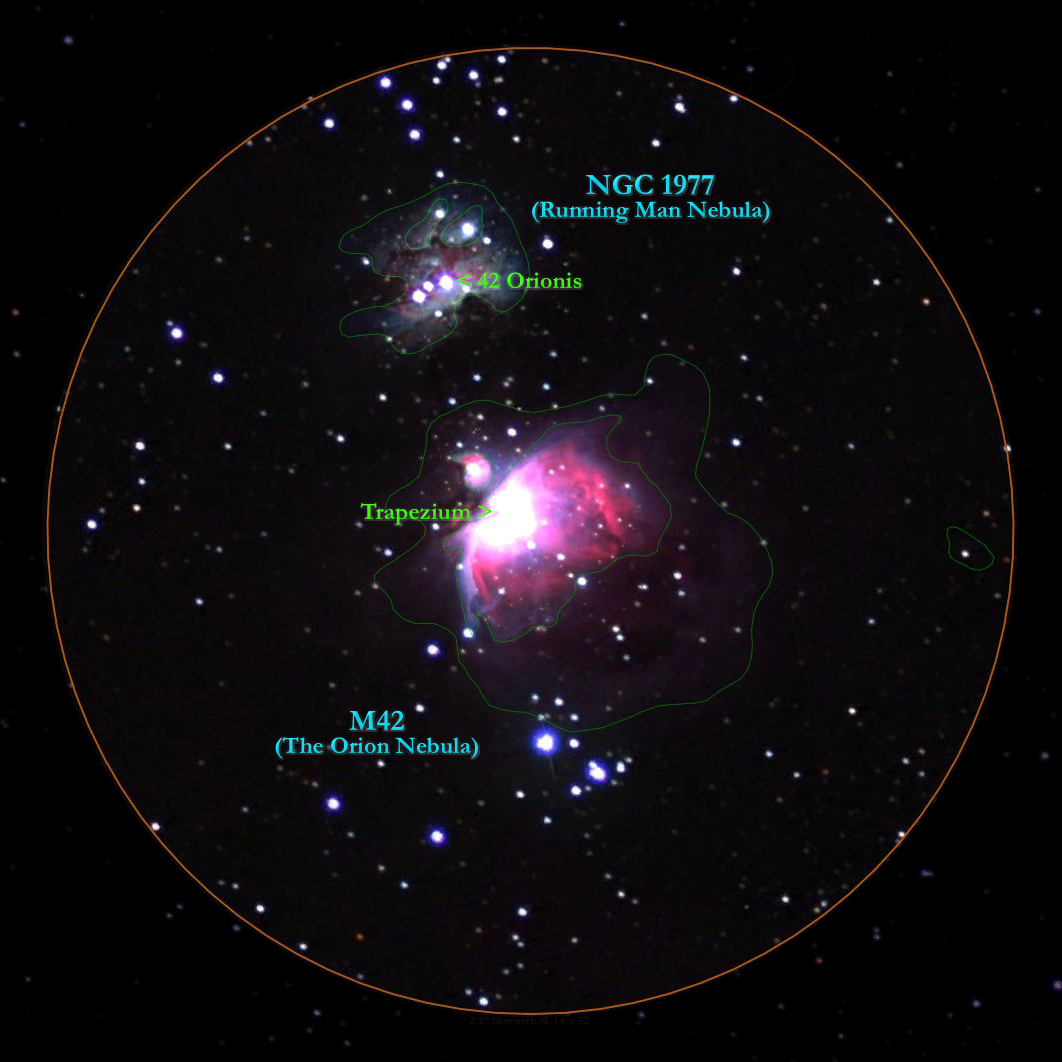
With the Orion constellation hanging behind the light-polluted haze of New York City, I poked around the busy stellar metropolis between NGC 1977 (also known as Sharpless 279) and Messier 42 (M42, or the Orion Nebula) in the so-called "sword of Orion."
The 14 mm ED eyepieces funneled enough photons to clearly separate the bright nebulosity around the Trapezium star cluster from the sisterhood of hot stars clustered around the binary, or double-star system 42 Orionis; the region sometimes called the "Running Man Nebula." But, given the NYC sky glow, I couldn't quite resolve the four brightest stars in the heart of the Trapezium nebula itself, whose dancing motions suggest they orbit a black hole of perhaps 150 solar masses — at 1,300 light-years, it is comparatively close to us.
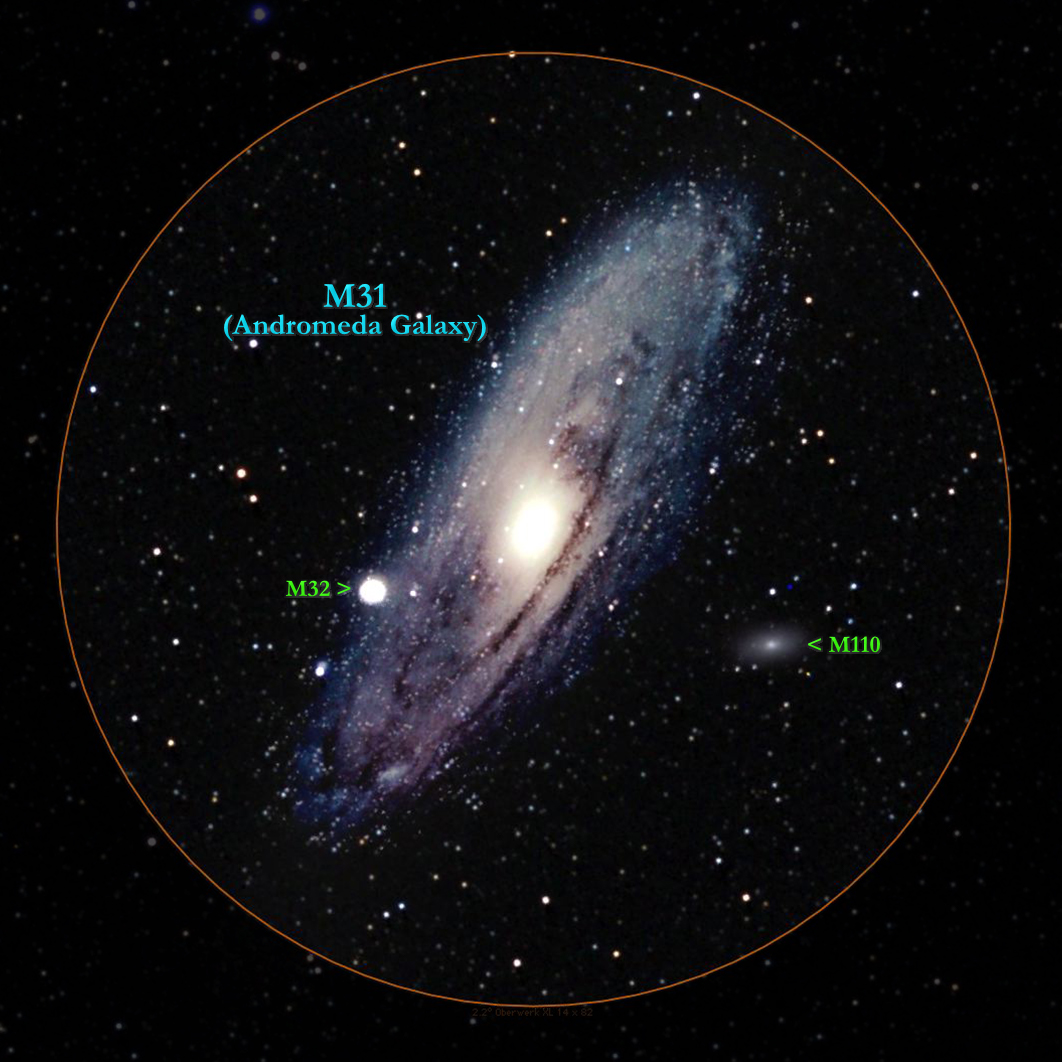
From my worst-case, sea-level, urban astronomy site, the Andromeda galaxy (M31) materialized as a glowing "furry football" — a fuzzy, elongated blob of light. Only the bright inner core was clearly visible: Under dark skies, on a moonless night, M31 should more or less fill the 14 mm eyepieces on the 82XL.
The dwarf elliptical galaxy M110, which orbits Andromeda, should show up as a "Mini-Me" satellite galaxy, 100,000 light-years behind its parent galaxy. And you'll be able to pick out the bright M32 dwarf galaxy as a round, fuzzy star in the foreground. Viewing with two eyes — plus knowing that one dwarf is "in front" of Andromeda's giant spiral and the other is "behind" — your brain will suddenly give you a 3D immersive feeling for the architecture of the universe. That's a powerful advantage of a great binocular telescope.
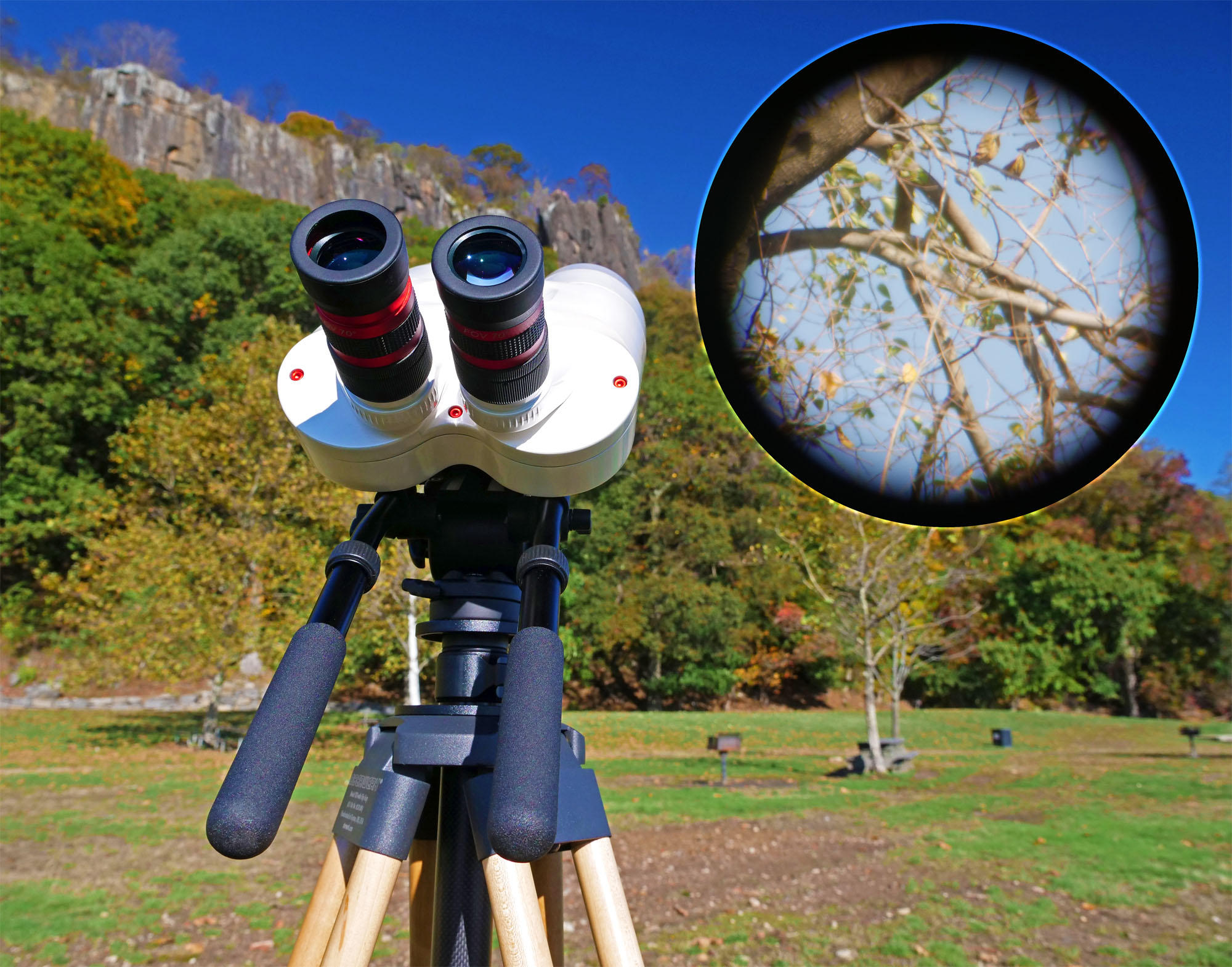
At home on Earth
On a crisp autumn day, I went hunting for peregrine falcons among the cliffs along the Hudson River. These birds are making a remarkable comeback in our neighborhood, thanks to effective clean air and clean water legislation. Hunting from on-high with their built-in binocular vision, they can come screaming down on prey at more than 230 mph (370 kph) — the fastest critters on the planet. I failed to spot any, but had an uplifting experience scanning along the rock faces and among the trees, resolving individual leaves from 300 yards (274 meters) distance. Immersed in the eyepieces, I felt a bit like a flying bird myself.
Looking out on the river, I watched a captain on the flying bridge of her tugboat pick up a walkie-talkie and give orders to deckhands as they warped a gravel barge around to weigh anchor and get underway. On the far shore, two dogs were racing each other in a wild game of fetch with their owner. From 4,570 feet (1,390 m) away, I could see one dog wearing a turquoise blue bandana as a collar ornament.
But, to have these kinds of enthralling experiences, you first have some set-up to do:
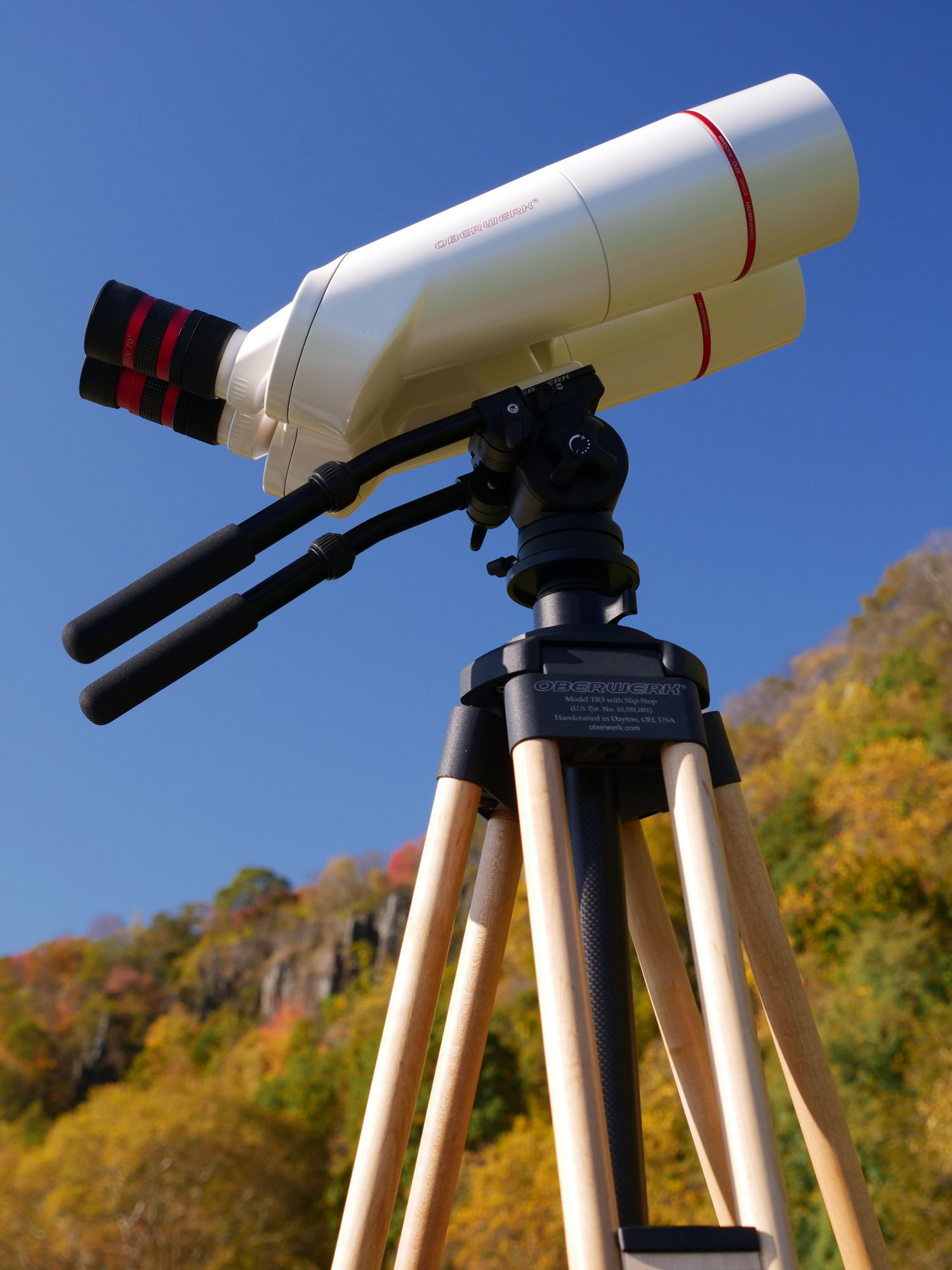
Setting up "the sticks"
Our review version BT-82XL-ED came in white "Luna Pearl" finish ("Big Eyes" speckle-finish gray is also available) on a "light-honey" toned maple TR3 tripod. Harder (and darker) walnut is available for $50 more. At first, I was skeptical of the idea of a wood tripod, picturing coarse, rough-hewn "surveyors' sticks." But the TR3 quickly won me over.
With any serious telescope, whether monocular or binocular, it's best to let your whole setup adjust to the outside ambient temperature before operating. Serious astronomers call this "equilibrating to ambient." But in the case of the Oberwerk XL I learned that it's wise to let the binocular and the tripod each stabilize separately, before trying to slip the binocular into its mount.
If you order a tripod from Oberwerk with your XLs, the binocular will come with a metal quick-release plate (Q/R-plate) installed. At first, my quick-release plate did not slide properly into its saddle. This turned out to be nothing more than the two parts having been kept at different temperatures; the 'pod outside in the breeze and the "bins" in the warm car. After a few minutes out in the cool air, the Q/R-plate contracted enough to smoothly slide into position, and its pressure lock securely snuggled up, gently locking it at its best balance-point.
Same rules apply to the TR3 wood tripod itself. At first, it was balky and did not want to extend. But after a few moments of cooling and, perhaps, some drying, the wood components contracted enough to slide easily by one another. But it didn't slip too much. Indeed, it couldn't: To keep the 'pod from suddenly crashing, Oberwerk has done the very clever — and very difficult — job of precision cutting the inside leg part's wood as an ever-widening wedge as it approaches the bottom.
Snug up the thumbscrews on the leg clamps to set your working height. Those clamps' grip may loosen, should the night get cooler and drier, but Oberwerk's "Slip-Stop" feature will prevent a crash catastrophe. I also noticed that, as the night goes on and fingers get cold, the warmer feel of wood is quite pleasant, compared to unsympathetic aluminum. (Just don't leave your beautiful precision-cut wood 'pod out in the rain and snow.)
The farther you deploy the tripod's legs to get the mount up to eye height, the wider those legs spread, of course. This is both good and bad: Wider is sturdier, transmitting less vibration, but it creates a bigger footprint to step around in the dark. A leg angle around 20 degrees is the sweet spot and Oberwerk has provided a graduated spreader to help you recall settings.
Once set for width, you'll want to solve for height. To make this easier, the TR3 comes with a carbon fiber central column or pier. Raise the tripod to the height at which the shortest person in your group can comfortably observe, then extend or shorten the column to accommodate everyone else, as they step up for a look. Just be sure to tighten the bat-handled lock ring with each setting. Even the smallest XL series binocular masses out at 8.5 lbs. (3.9 kilograms); you don't want it sandwiching your fingers between head and tripod mantle, if the column slides down because you failed to secure it.
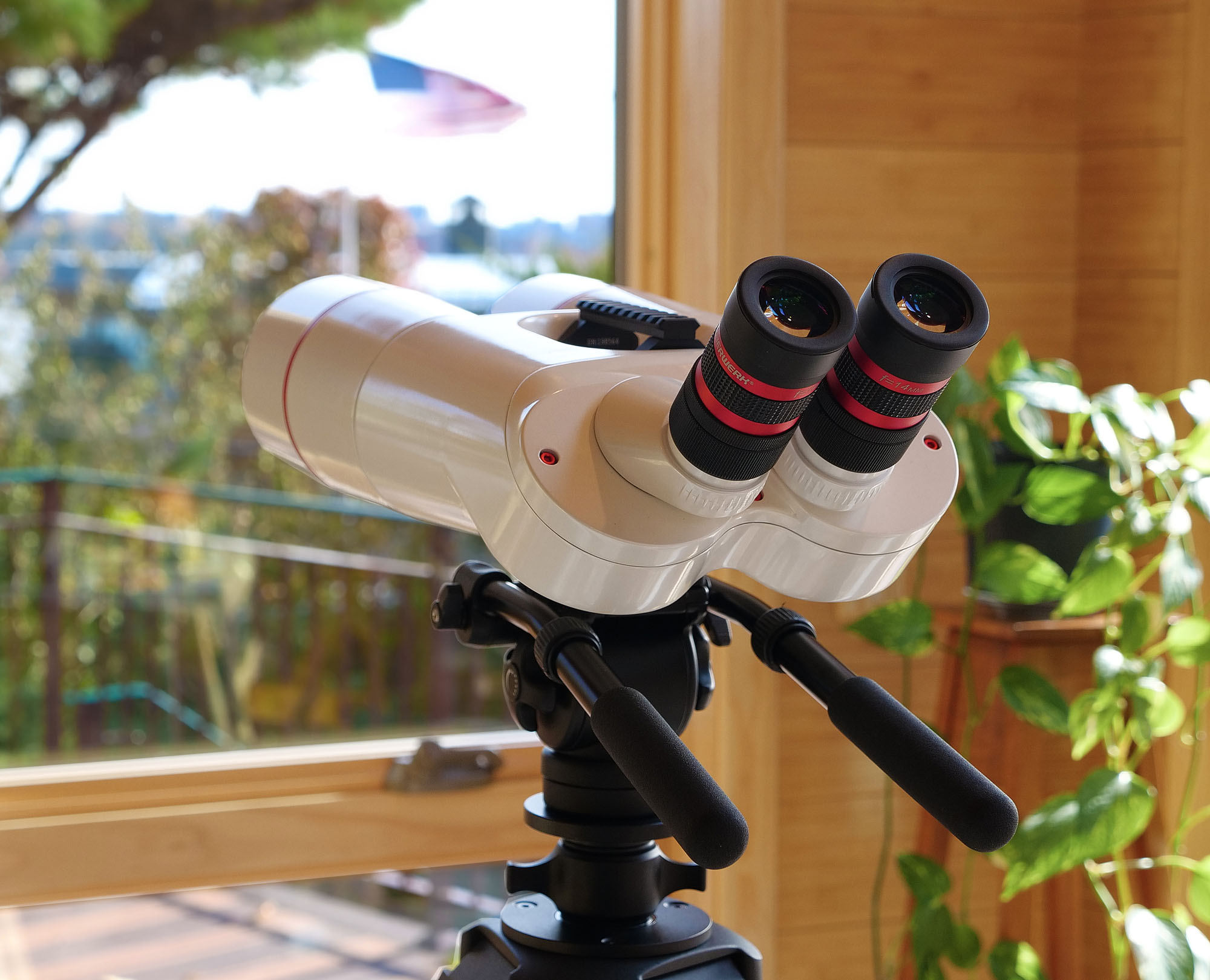
Wait, the head goes backwards?
Yes. Yes, it does. Oberwerk's TR3 hardwood tripod (suitable for the XL binocular line) typically comes with an Oberwerk 5000 "video head." (Oberwerk also resells the more upscale Manfrotto 608 head.)
Alternatively, you could use any tripod with a "fluid" video head that's rated for a 13 lbs. (6 kg) mass, but the stock Oberwerk 5000 solution is probably all you'll need for astronomy. I'm a video guy, so I immediately assembled the rig as a proper video shooter would: I stuck the handles at the rear of the head for smooth panning and tilting. That's fine for daytime terrestrial targets. But, at night, Oberwerk wants you to set the bins upon the video head "backwards," for a very good reason: This lets you tilt a full 90 degrees up to the zenith, where the atmosphere between you and the universe is thinnest. A typical video head will let you shoot straight down at the floor but not straight up into the sky. So, reverse it!
Rigging it Oberwerk's backwards way has the additional benefit of shortening the handles; because they are now screwed into the "front" of the mount, there's less chance they'll poke you in the chest as you sidle up to the eyepieces. (This backwards-handle strategy does impinge slightly on the knob that locks the quick-release. So, when you're ready to call it a night, just remove or loosen that handle first.)
Related: Video astronomy: Bring the universe to your friends with Celestron's RASA 8 telescope
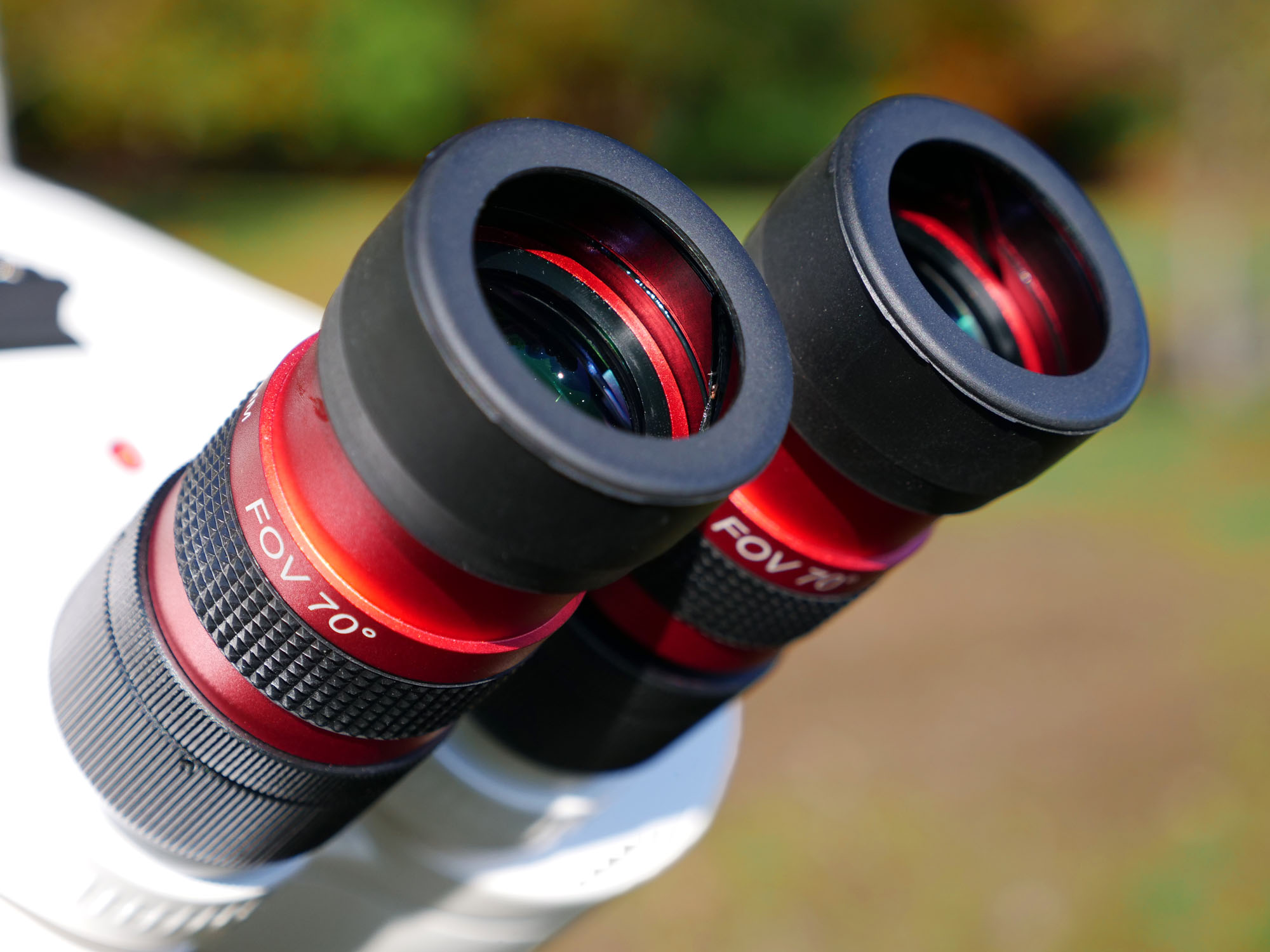
Those eyepieces are astronomy-standard 1.25 inches (3 cm) diameter. Oberwerk supplies 14 mm eyepieces, of excellent quality and convenient power (32x), in the midrange between wide field and high magnification. To pull bright planets in closer, you could step up as far as 7 mm (64x magnification) with full undistorted color. Or even a bit more with very high quality (expensive!) eyepieces, from high end makers like Televue, Explore Scientific and Baader.
Thy IPD, unique
Each human face is gloriously unique. My eyes, for example, are very closely set, compared to most people's. The bridge of my nose is much less wide than the width of one of my eyes. In technical terms, my "interocular distance" is shorter than the "interpupillary distance" (IPD) of most binoculars. But not the Oberwerk XLs, whose eyepiece-turrets can be rotated in and out, across the full range of human countenances, from 50 mm (for kids, and narrow-headed adults like me) to 80 mm (think: Kim Kardashian or Brandy Norwood).
There's a lock ring for each eyepiece "above" — closer to your eye — and thinner than the focuser. Though both are knurled, Oberwerk has made them very different widths so you won't confuse them in the dark. It's not likely that your eyepieces will fall out on their own, but please lock them just in case one or both are inadvertently bumped.
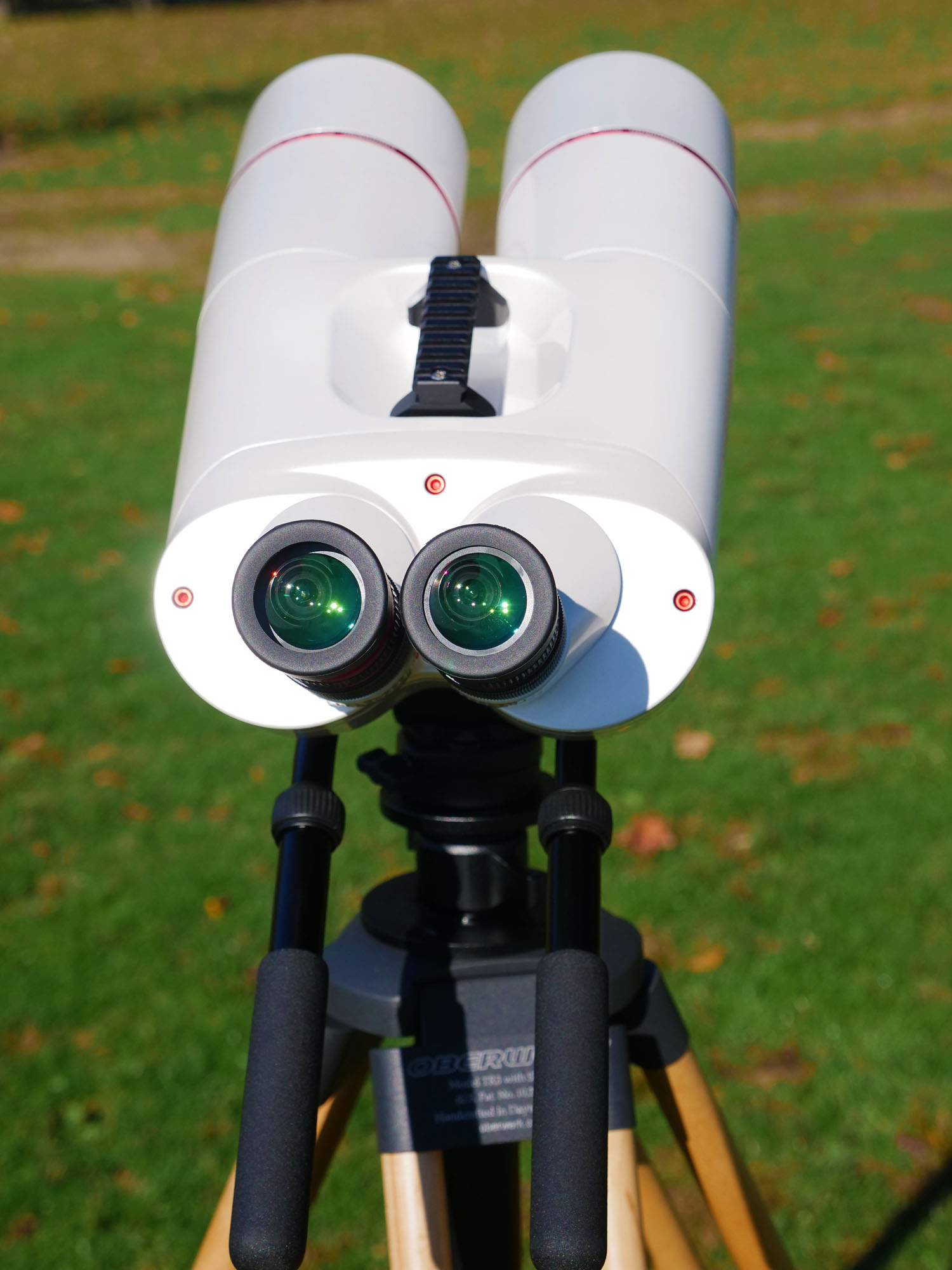
Angled for comfort
Most binoculars put your eyes parallel to, and in-line with, the large front objective lenses. For astronomy, the higher you point into the sky, the more uncomfortable this can get. But Oberwerk's XL line cures this: The eyepiece-turrets are angled at 45 degrees. So, your face is tilted slightly down to observe objects at the horizon; moonrise is delicious! You face directly out to view targets halfway up the sky, and your neck has to bend only slightly back for objects high up on the dome of the night. But you don't have to adjust the height of the tripod's column very much as your viewing angle changes. For those familiar with standard monocular telescopes, it's like having two refractors, side by side, each with a 45-degree "correct image" prism diagonal.
You focus each side separately. The right side twists clockwise to extend (raise) the lens; the left twists counterclockwise. It's best to start by focusing one eye at a time. But, once your image is crisp, you can make small refinements of either side with both eyes open; it's a little "trippy" but not headache-inducing.
The niceties of rarified luxury
There's a constant scrum going on between binocular brands at the smaller sizes and cheap-to-midrange price points. Each tries hard to differentiate their model, despite the fact that most are selling essentially the same or very similar optical platforms (many binoculars sold under several different brand banners are actually all made in the same Chinese factory, of mostly identical parts). Stepping up into the Oberwerk XL range of binocular buys you a level of accuracy, opulence of finish and cleverness of design you might associate with an expensive automobile or fine timepiece.
As objective lenses grow larger and magnification powers increase, it becomes more difficult to get left and right images to accurately merge. In the ideal case, each binocular should be checked, and hand tuned, as a final step before shipment. Oberwerk is one of the few makers that does this. You'll particularly appreciate the benefits of their extra work when you step up to very high magnifications.
Each XL binocular telescope comes in a sturdy case, framed in tough aluminum, with a flat-fold handle. It's just small enough to be allowed as airline carry-on baggage on most U.S. carriers. The interior shock foam is contoured to cradle the bins, with separate nests for two eyepieces. The finish on the binocular's magnesium body is smooth on the white model and textured on the gray. With either, you'll feel a bit like you're lifting the Queen's crown jewels or a Stradivarius violin out of their security case.
Whereas cheaper binoculars come with plastic or rubber covers that loosely fit (and often fall off of) the main objectives, the Oberwerk XL's lens covers are crafted of aircraft aluminum with precision threads. Accurately milled glare-shield rings gently slide out to block the daytime sun and lessen the foggy curse of nighttime dew.
Investing in expensive telescopes or binoculars frequently entices buyers to customize their gear. (I know I suffer from the addiction of gadget-lust!) Oberwerk offers a menu of specific accessories: For observing the sun (big fun during active sunspot years!) Oberwerk will sell you a pair of Seymour solar filters at $95 for film, or $185 for glass.
Some very large binoculars require a finder scope, especially when used for astronomy. Oberwerk XLs don't need a separate scope, but you can add a helpful red or green illuminated, multi-pattern reticle for $49.95. It doesn't have — and doesn't need — any magnification to help you point on a target. If you do prefer a magnifying finder-scope, or a laser sight (or any other line-of-sight attachment), the XLs all carry a standard Picatinny Rail (Military Standard 1913) platform atop their built-in carry handle.
For $25, Oberwerk will custom make a laser-engraved tripod plate with your choice of text. This could be a "property of" identifier, a "custom made for" tag, a snippet of cosmic poetry or anything you like — up to 90 characters — on three lines.
Various gadgets are available to position a smartphone or tablet camera at one eyepiece for "afocal" photography.
Regrets, I have a few
The exit pupils — those small bright circles that seem to float just above the eyepiece where the image forms — are, at 2.55 mm for the supplied 14 mm eyepieces, a bit small. It takes a few moments, and some experimentation with rotating the eyepiece turrets, for novice users to get both eyes aligned. Changing out the eyepieces to Oberwerk's wider-field (less powerful) 22 mm eyepieces expands that exit pupil to a more comfortable 4 mm, making it easier to fuse the view.
There's an important lesson here: Don't get trapped in pursuing ever-higher magnification; a lot of the grandeur and majesty of nature is best appreciated with a wider stereo view. This is especially noticeable with great binoculars like these at night.
The Oberwerk 5000 head is nicely fluid in the tilt (pitch/up-down) plane, but somewhat jerky in the pan (yaw) plane. This is not a problem with astronomical objects whose apparent motion is either very slow or too fast to track (think: space station or meteors). But it is not that easy to smoothly follow terrestrial action, like fast powerboats or migrating animals. If you think tracking targets will be important, consider upgrading to the more expensive Manfrotto 608 Nitrotech fluid video head.
Although the wood TR3 tripod transmits less vibration than would an aluminum or carbon fiber pod, there is still noticeable shake when viewing from cantilevered decks or indoor floors. This can be damped a bit with a kit of three isolation pads, available from Meade, Celestron and various sellers.
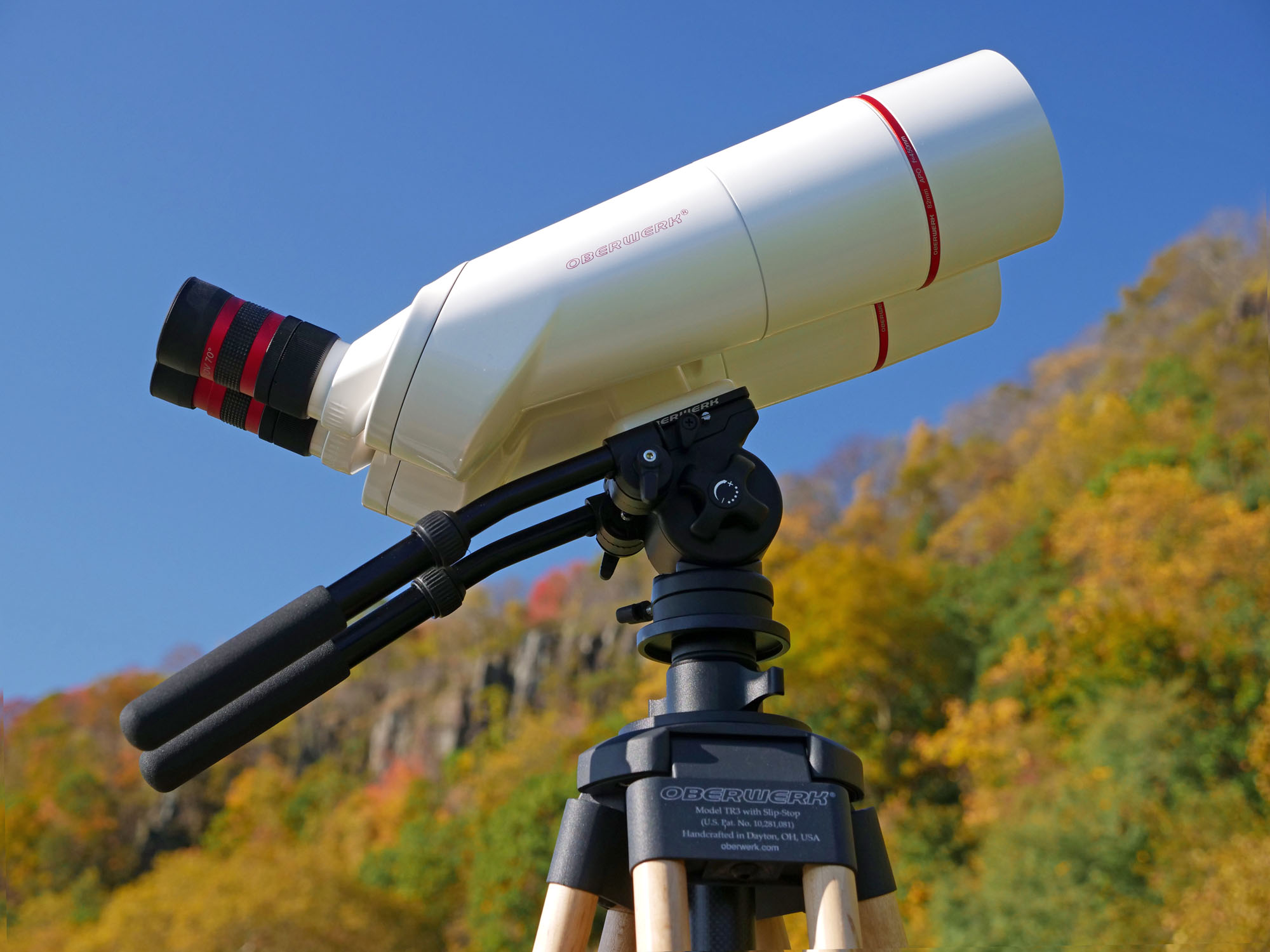
Two eyed telescopes
Humans are a fascinating blend of predator and prey. Selective pressures have generally tended to push the eyes of prey animals to the sides for wider vision. Hunting species triangulate by using the parallax of their more forward-facing eyes to better calculate attack-distances ("stereopsis"). Our eyes can see up to 190 degrees of panoramic view, but only about 120 degrees of that is binocular (using both eyes), capable of discerning depth and distance. During the day, we can tell if something is hiding behind an object even if only one of our eyes can see it. (Leonardo da Vinci was one of the first to note this ability.)
Looking into the night sky, each of our eyes informs the brain, which integrates to build up a more accurate image of each object. This is known as "binocular summation" and is the best reason to think about a two-eyed telescope.
For a completely immersive "spacewalking" experience at night, or superbly accurate nature viewing during the day, at a price within range of most serious enthusiasts, Oberwerk's BT XL-ED binocular telescopes beat all competitors. For those who can afford — and would truly appreciate — an "heirloom" binocular telescope, any of Oberwerks BT XL-ED line would be a strong, high value investment.
| Focal Length | 450 mm |
| Field of view | 2.2° (32x) |
| Exit Pupil | 2.57 mm (32x) |
| Eye Relief | 18 mm (32x) |
| Minimum Focus | 25 meters |
| Interpupil Distance | 50-80 mm |
| Binocular Weight | 10.3 lbs |
Follow this author on Twitter @DavidSkyBrody. Follow us on Twitter @Spacedotcom and on Facebook.
Join our Space Forums to keep talking space on the latest missions, night sky and more! And if you have a news tip, correction or comment, let us know at: community@space.com.
Dave Brody has been a writer and Executive Producer at SPACE.com since January 2000. He created and hosted space science video for Starry Night astronomy software, Orion Telescopes and SPACE.com TV. A career space documentarian and journalist, Brody was the Supervising Producer of the long running Inside Space news magazine television program on SYFY. Follow Dave on Twitter @DavidSkyBrody.
